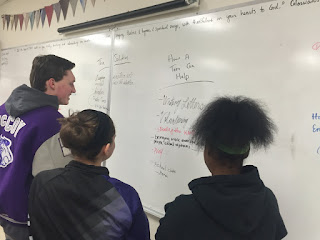A high school student asked, "Mr. Dunlap, what J-Term class are you teaching this year?"
Me: "Orphan care."
Him: "Oh..."
I got a chuckle out of that conversation. I explained to the student that I have two main passions, and this year I wanted to focus on the other passion. As a technology teacher, the expectation would be that my J-Term class would focus on technology in some way. Most of my students know that I'm an adoptive dad, and it just makes perfect sense that I care deeply about caring for the fatherless.
We hold J-Term for our middle and high school students during the first week back from Christmas Break. Classes are roughly 2 1/2 hours long each and have nothing to do with the regular curriculum.
One of my colleagues, Jessica Finney, and I teamed up to teach the class. I was a bit disappointed that our class had only four students, but I can honestly say that they were the right four students. By selecting our class, they had to give up the chance to decorate cakes, survive in the wilderness, crochet, take care of cats in a shelter, and do a host of other fun classes. Obviously, they had a reason to want to learn about serving the fatherless before they walked into class on Monday.
Show Hope has a great student club, called
The Movement, which provides materials necessary to launch high schoolers into action. The goal was to use this curriculum heavily to help us through the week. However, something strange happened when we got students in front of us.... They connected better with personal stories. They soaked in the stories we told and kept asking more and more questions. They wanted to watch more videos about adoption and foster care. In short, they couldn't get enough stories.
To quote
Chris Wheeler from Show Hope, the intent is to move students "from unaware to aware to action."
The "unaware to aware" part was easy. We just put on a parade of guest speakers to talk about how adoption has affected their lives. I'll list the guest speakers below, but we hit a broad range of topics just by talking about personal experiences. Domestic and international adoption and foster care were certainly part of our discussions. However, we talked about
why there is an orphan crisis to begin with -- unwanted pregnancies, abusive parents, and poverty to name a few. We talked quite a bit about the costs of adoption and ways to fund adoptions. We showed videos and looked at blogs and Instagram posts. We invited speakers in via Skype. We also talked about
Compassion International which is an organization that helps to end poverty in third world counties. By sponsoring a child, you provide them with food and education to help them make a difference in their country. If you look hard enough, there are examples all around of the orphan crisis and how someone can stand up for orphans. And that doesn't always mean adoption. There are tons of ways to help someone in need.
To be honest, I am stunned how much we covered in a short time. On Wednesday, we put three columns on the board (The Problem, The Solution, How a Teen Can Help) and asked them to fill the columns with their ideas. In my opinion this was a watershed moment for the class. We took all our thoughts swirling in our heads and got them written down in front of our faces.
In the second half of the week, we got more personal by talking to the students' peers. We had a total of four visitors, three girls who have been adopted and a fourth whose two sisters were adopted out of foster care. All four stories were incredibly different, but it helped our students see how adoption can even influence people they know well.
The second part of the plan was to move from "aware to action." That was a bit tougher. First, it's not right to assume a student
wants to be part of the solution. Second, the students need to take ownership of the action. I could certainly push them to do some things but for it to be meaningful the ideas really had to be their own.
It was so encouraging to hear them talk about wanting to be adoptive parents or siblings. At least two of them are contemplating taking missions trips to China. We've talked about starting a club next year and about how a college student can be an advocate for orphans. I wouldn't be surprised if this summer finds a volleyball camp at our school for foster kids and it won't be long before awareness posters are up in the hallways at school.
Sadly we ran out of time before we put together a solid action plan for the future, but I'm just excited to see teens with a desire to help those in need.
Now, to my thank you section...
- Jessica Finney -- teacher at MVCA and future foster/adoptive mom. When I say "we," many times I mean "she." Jessica has broad knowledge of anything dealing with foster care, adoption, and helping those in poverty.
- Shawn Baker -- adoptive dad and Founder of Zoe's House.
- Randy Bohlender -- adoptive dad and Executive Director of Zoe's House.
- Lynn Woods -- True Voices
- Kay Pardue -- Show Hope
- Chris Wheeler -- adoptive dad and Director of Student Initiatives at Show Hope
- Robert Vilardo -- adoptive dad and Athletic Director at MVCA
- Amy Kinnell -- adoptive mom and case worker with Adoption Assistance
- Those four girls who shared with our class. They will remain nameless but we appreciate making their personal stories public.
- The four students in class who moved from unaware to action. Wow! Can't wait to see what happens next!















